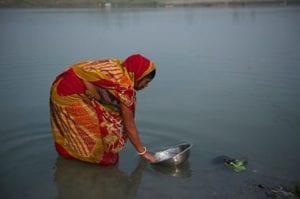Lack of progress on sanitation threatens to undermine the environmental health benefits from gains in access to safe drinking water, warn WHO and UNICEF in a report tracking access to drinking water and sanitation against the Millennium Development Goals.
The Joint Monitoring Programme report, Progress on Sanitation and Drinking Water: 2015 Update and MDG Assessment, says worldwide, one in three people, or 2.4 billion, are still without sanitation facilities – including 946 million people who defecate in the open. The environmental impact of this practice is ground water pollution. It can also lead to higher risks of growth stunting or chronic malnutrition – which affects 161 million children worldwide, leaving them with irreversible physical and cognitive damage. “What the data really show is the need to focus on inequalities as the only way to achieve sustainable progress,” said Sanjay Wijesekera, head of UNICEF’s global water, sanitation and hygiene programmes. “The global model so far has been that the wealthiest move ahead first, and only when they have access do the poorest start catching up. If we are to reach universal access to sanitation by 2030, we need to ensure the poorest start making progress right away.” Water access Access to improved drinking water sources has been a major achievement for countries and the international community. With some 2.6 billion people having gained access since 1990, 91% of the global population now have *improved drinking water – and the number is still growing. In sub-Saharan Africa, for example, 427 million people have gained access – an average of 47 000 people per day every day for 25 years. Sanitation stymied On the other hand, the progress on sanitation has been hampered by inadequate investments in behaviour change campaigns, lack of affordable products for the poor, and social norms which accept or even encourage open defecation. Although some 2.1 billion people have gained access to *improved sanitation since 1990, the world has missed the MDG target by nearly 700 million people. Today, only 68% of the world’s population uses an improved sanitation facility – nine percentage points below the MDG target of 77%. “Until everyone has access to adequate sanitation facilities, the quality of water supplies will be undermined and too many people will continue to die from waterborne and water-related diseases,” said Dr Maria Neira, Director of the WHO Department of Public Health, Environmental and Social Determinants of Health.Addressing inequality
“To benefit human health it is vital to further accelerate progress on sanitation, particularly in rural and underserved areas,” added Dr Neira. Rural areas are home to seven out of 10 people without access to improved sanitation and nine out of 10 people who defecate in the open. Sustainable Development Goals Plans for the new Sustainable Development Goals (SDGs) to replace the MDGs will be released United Nations early next year and are set to include a target to eliminate open defecation by 2030. This would require a doubling of current rates of reduction, especially in South Asia and sub-Saharan Africa. WHO and UNICEF report says it is vital to learn from the uneven progress of the 1990-2015 period to ensure that the SDGs close the inequality gaps and achieve universal access to water and sanitation. Notes *An “improved” drinking water source is defined as a facility or delivery point that protects water from external contamination – particularly faecal contamination. This includes piped water into a dwelling, plot, or yard; public tap or standpipe; tube-well or borehole; protected spring; and rainwater collection.*An “improved” sanitation facility is one that hygienically separates human excreta from human contact.








